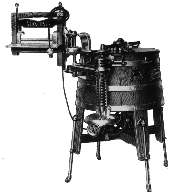 This toy did nothing more than help one create a creepy clown face with different color translucent pegs. Nothing more or nothing less, but its simple construction and almost pothead concept was in a word brilliant. Like most objects that have a cult following, it inspired a subculture of Lite-Brite art.
This toy did nothing more than help one create a creepy clown face with different color translucent pegs. Nothing more or nothing less, but its simple construction and almost pothead concept was in a word brilliant. Like most objects that have a cult following, it inspired a subculture of Lite-Brite art.
The Lite-Brite is shaped like that the back of an old tube TV, with a removable light socket, a black grid of holes on the front held the white body by 2 screws. One placed a back sheet on construction paper over the grid and began pushing the paper with the pegs to make a picture while the light was on. The colors of the pegs were: red, blue, green, yellow, pink, purple, orange, and clear. The packaging of the Lite-Brite featured a boy and a girl, working together on a sailboat, which was part of one of the deigns, but the preprogramed designs were somewhat limited, but not limited in ones imagination. Other icons over the years have sold their imagines to be used in add-on designs. those first add-on designs, were Mickey Mouse (Of course), Scooby-Doo, Flintstones, and a host of others.
SIDEBAR: My brother and I had a Lite-Brite and the box had a creepy clown on the box (see images).
One draw back of the Lite-Brite was losing pegs, swallowing pegs, and getting them stuck in ears and nose. Why is this important? Its one of the last toys to have small parts that can be harmful for children.
The Lite-Brite is produced by Hasbro and began marketing it in 1967. The Lite-Brite has not gone away but it exist in different forms today. LB comes in a LED version, a Cube version, and also as an app for tablets. One can find a used one in most yard sales, or theft shops, less the legs and the design book, which replacements can be found on-line. The Lite-Brite, like the etch-a-scotch, has created a subculture of LiteBrite artists. Please feel free to visit the Indianapolis Children's Museum for an large scale Lite-Brite interactive. Providence Children’s Museum also has a large scale Lite-Brite as well that is larger than the one in Indianapolis. But locating photographs of it seems impossible.
 |
| My Brother's and mind Lite-Brite box |
 |
| The Lady and The Unicorn Tapestry 15th Century |
 |
| The Lady and The Unicorn Tapestry (Lite-Brite) |









